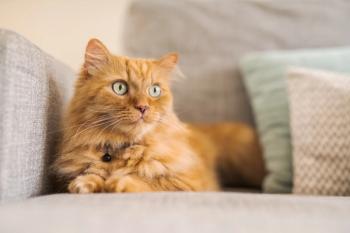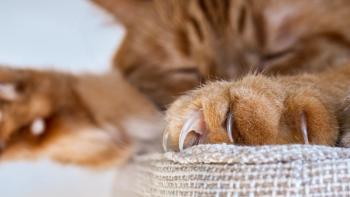
Practical fluid therapy (Proceedings)
The goals of fluid therapy in camelids are similar to those in other species. The mechanics and details are somewhat different. Of the possible routes, oral and intravenous are the major routes used to correct problems of hydration. Subcutaneous, intraperitoneal, and intraosseus administration all have specialty applications, but are not useful or necessary in most situations.
The goals of fluid therapy in camelids are similar to those in other species. The mechanics and details are somewhat different. Of the possible routes, oral and intravenous are the major routes used to correct problems of hydration. Subcutaneous, intraperitoneal, and intraosseus administration all have specialty applications, but are not useful or necessary in most situations.
ORAL FLUIDS
Oral fluids are best administered by tube. I prefer to pass the tube through the mouth, as camelids have very narrow nasal passages. Small bore feeding tubes can be used nasally in crias and left in place. Passing an orogastric tube on an adult camelid can induce struggling and a stress response, so it is important to assess whether the patient can tolerate the procedure, have a plan to perform the procedure quickly and competently, and have a plan to abort the procedure if necessary. Alpacas may be manually restrained, whereas llamas may be better restrained in a llama chute. Sedation may help. My preference is to use intramuscular butorphanol, which has less deleterious effects on airway protective responses or cardiac output than many other sedatives. For a speculum, we use a block of wood with the edges rounded and a hole drilled through the center that the tube can fit through. The block is introduced from the side into the interdental space, then seated onto the molars. The tube is passed through the hole, over the base of the tongue and into the esophagus. Negative pressure when sucking back on the tube, palpating the tube adjacent to the cervical trachea, or hearing fluid bubbles over the abdomen when blowing on the tube confirm correct placement.
The camelid may respond by struggling, regurgitating, or going into respiratory distress. Any of these may lead to reassessment of the adequacy or restraint or the safety of the procedure.
Once the tube is in place, we usually think it is safe to administer up to about 3.5% of total body weight in fluids at one time (3.5 L to a 100 kg llama). Administering more may be safe in some situations, but also increases the chances of gastric regurgitation. That amount may be given every few hours, unless gastric distention develops, but we usually try to limit ourselves to 3 tubings a day.
The easiest thing to give by tube is water. In dehydrated camelids that have a tendency towards hypernatremia and hyperchloremia, that may be acceptable, but it is likely that a salt solution with an osmolality similar to plasma will have fewer shock effects on gastric microbes, and may be absorbed better. We generally avoid calf electrolyte powders because of the sugar, and make our own isotonic salt solutions.
INTRAVENOUS FLUIDS
Much has been made of the difficulty of catheterization in recent years. In my opinion, there are six identifiable and preventable problems that may inhibit catheterizations:
1) Inadequate restraint. We use a restraint chute for most adult camelids, and chemical restraint with butorphanol if needed.
2) Inadequate identification of the cervical landmarks. The jugular vein runs between the trachea and the transverse processes of the cervical vertebrae. If the vein itself cannot be visualized by holding it off and then letting off the pressure, the point midway between these landmarks approximately one-third of the distance from the ramus on the mandible toward the shoulders is a good place to try.
3) Too much local anesthetic. Camelid skin is very thick. A large bleb of local will tend to compress in and hence block venous flow, rather than blebbing out the skin. I try to use no more than 0.5 cc.
4) Not puncturing the skin full thickness prior to catheterization. The vein is very superficial. If you try to introduce a catheter through uncut skin, often the initial momentum of passing it through the resistant tissue propels the catheter through the jugular vein before you realize it. I pick up the skin below my bleb, pull it away from the vein, and make a full-thickness stab incision with a #15 blade. If I feel resistance or see the skin depress as I try to introduce the catheter, I repeat the stab incision.
5) Going too deep. This is rarely a problem, unless #2 or #4 were also problems. If you are in the right place and do not miss the jugular on the first stab, then it should be the first vascular structure you encounter. Going too deep may lead to inadvertent carotid puncture. This is best recognized by the rapid back-flow of blood. I immediately hold off the site where I believe the carotid was punctured, withdraw my catheter and apply firm pressure for 5 minutes. If you respond quickly, you can simply try again. If a large hematoma develops, it may be better to choose another site where the anatomy is less affected. On the next attempt, blood coming back from a hematoma may resemble blood from a successful catheterization, except that the catheter will not feed.
6) Getting frustrated. Suffice it to say here that most camelids can be catheterized, and that practice, the right technique and equipment, good restraint facilities, and possible sedation make the procedure more successful. If you are not having success, a deep breath, a short break, and a reassessment of landmarks is usually warranted.
Once the catheter is in place, a new set of problems arise.
In general, intravenous fluid therapy can be divided into two phases: replacement and maintenance. Replacement involves estimation of the fluid deficit, which is difficult in camelids. These animals are very adept at dealing with dehydration. Their ovoid erythrocytes are resistant to osmotic changes and their rate of urine production is below many other species. Their firm skin does not tent or wrinkle readily, leaving oral and ocular mucous membrane moisture one of the best physical indicators of dehydration. They can voluntarily stop drinking, and will frequently do so in hospital situations. In these cases, frequency of urination may be helpful. Less than about 3 times a day may reflect dehydration.
Clinical pathology indicators of hydration are all problematic in camelids. Sick camelids have trends towards both anemia and hypoproteinemia. Thus lack of evidence of hemoconcentration or hyperalbuminemia cannot be used as indicators or adequate hydration. They may have trends towards hypernatremia and hyperchloremia, but these are inconsistent. About 10-20% of all camelid blood samples analyzed at Oregon State show evidence of azotemia, but more commonly this is due to a high BUN, which may reflect a gastric microbial die-off rather than decreased renal function. Increases in creatinine, though more specific, are far less common. Acidosis and hyperlactemia, evidence of poor circulatory function are also important if found, but rare. Similar to horses, camelids with poor circulatory function frequently are suffering from toxemia or some other factor which decreases vascular tone or leads to pooling of fluid, rather than overt dehydration.
The bottom line is that since camelids are so adapted to dehydration, they are probably more tolerant of SLOW replacement of deficits, rather than bolus correction. Unless dehydration is clear, and lack of rapid correction has life-threatening implications, we seldom bolus more than 2% of body weight to sick camelids on admission. If dehydration is clear and life-threatening, we may bolus up to 4%, and in extremely rare cases, such as neonates with hyperosmolar disorder and hyperalbuminemia, we may bolus up to 10% of body weight, but these are the exceptions.
The risk of larger boluses is edema. In hypoproteinemic camelids, edema can rapidly impair pulmonary function, and the camelid may die of respiratory distress. The easily outweighs the risk of prolonged underperfusion at our clinic. The major risks of underperfusion relate to other medications: aminoglycoside antibiotics and non-steroidal anti-inflammatory drugs are both more toxic to the dehydrated animal. We must use these with caution, or not at all, if we have questions about adequate circulatory volume and function.
Maintenance fluids basically come with the same warning. Hypoproteinemia and edema are the two biggest risks. There is not much information about maintenance requirements in camelids: rates from 2 to 10% of body weight per day appear in the literature. Ten percent is clearly too high, except maybe for neonates, and the risk of edema formation is high. Two percent may be adequate, but hardly justifies the catheter. Coupled with a conservative replacement philosophy, we like to administer maintenance fluids at a slightly higher rate than the bare minimum in order to correct deficits that we have missed in the initial bolus. Five percent of body weight appears to have little risk, promote urination such that iatrogenic toxicities are rare, and not affect blood protein concentrations too much.
The next question is what to give. Hypernatremia and hyperchloremia are far more common than the opposites at our clinic. Hypokalemia is common. Acidosis is rare, but an important finding. Alkalosis is more common, but usually mild and benign. Mineral abnormalities are usually likewise mild and benign. We can tinker with the fluids based on individual abnormalities, but the bottom line is that a plain balanced electrolyte solution is well suited to replacement therapy, and the same with supplemental potassium (and maybe calcium) is suited to maintenance therapy. My preference is to use a fluid with acetate as its base rather than lactate.
Up to two-thirds of the camelids at our clinic show evidence of fat mobilization. If this is severe enough, we often use a partial parenteral nutrition formula for our maintenance fluids. Our most common recipe for this is:
5000 mls acetate-containing electrolyte solution
1000 mls 8.5% amino acid solution
500 mls 50% dextrose
130 mEq Potassium (in KCl)
20 mls B-vitamins
We administer this solution at 5% of body weight/day (2 ml/kg/h) using infusion pumps. Both the b-vitamins and amino acid solutions are light-sensitive, so the bags must be covered. We also administer insulin during the course of PPN treatment. For most camelids, we use human recombinant insulin Ultralente at 0.4 U/kg q 24 hours given subcutaneously. For overtly lipemic camelids, or ones with very high beta-hydroxybutyrate or NEFA values, we may use the Ultralente insulin as often as twice a day (it lasts about 12 hours) or supplement in with intravenous regular insulin at 0.2 U/kg as often as hourly.
The rationale for the PPN is as follows: we administer the insulin to arrest fat mobilization and promote triglyceride clearance. We administer the dextrose to prevent hyperglycemia and also to provide some alternate energy to the patient. We administer the amino acid solution to provide some energy substrate and hopefully spare the protein-scavenging, cachexia effect. The b-vitamins might also increase the usability of the glucose. We can usually arrest fat mobilization and clear hypertriglyceridemia within 48 hours, using this treatment scheme.
Newsletter
From exam room tips to practice management insights, get trusted veterinary news delivered straight to your inbox—subscribe to dvm360.






